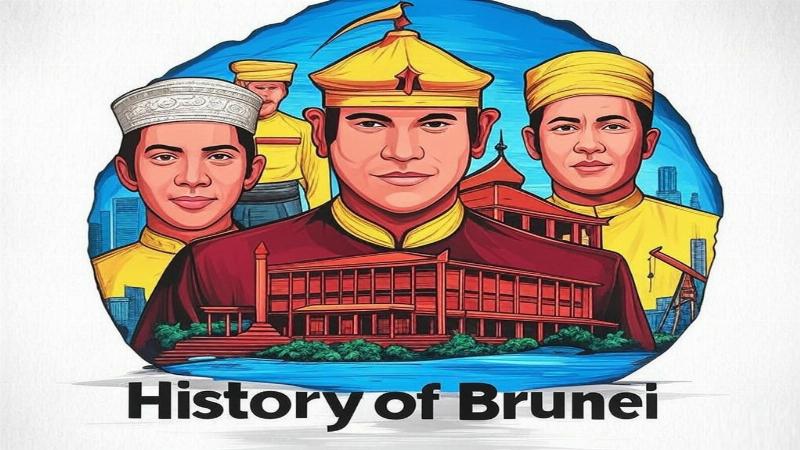Place for ads

Brunei, a tiny sultanate on the northern coast of Borneo, is a land where golden domes gleam against lush rainforests. Covering just 5,765 square kilometers, it nestles between Malaysia’s Sarawak and Sabah, its shores lapped by the South China Sea. Known today for its oil wealth and absolute monarchy, Brunei’s history is a fascinating blend of ancient maritime glory, colonial encounters, and modern prosperity. In this article, we’ll journey through Brunei’s past, from its earliest days to its contemporary identity, uncovering the milestones that have shaped this unique nation.
Brunei’s human story begins around 40,000 BCE, with evidence of early inhabitants in Borneo’s caves. Niah Caves, near Brunei’s border, reveal tools and skulls from this Paleolithic era, suggesting hunter-gatherers thrived in the region. By 2000 BCE, Austronesian peoples arrived, bringing rice farming and boat-building—skills that would define Brunei’s future.
Archaeological finds—like pottery at Sungai Limau—date to 1000 BCE, hinting at trade with mainland Southeast Asia. These early communities fished and gathered sago, their dugout canoes navigating rivers like the Brunei River. By 500 CE, coastal settlements emerged, precursors to the maritime culture that would rise centuries later.
By
Place for ads
The 10th century saw Brunei grow into a thalassocracy—a sea-based empire—ruling Borneo’s coast and parts of the Philippines. Arab traders introduced Islam by the 13th century, with Sultan Muhammad Shah (circa 1368) as the first Muslim ruler. Tombs at Rangas and Islamic inscriptions mark this shift, cementing Brunei’s Muslim identity.
The 15th century heralded Brunei’s peak under Sultan Bolkiah (1485–1524), the fifth sultan. His fleets dominated Southeast Asia—chronicles boast control from Java to Luzon, taxing trade in spices and gold. Kampong Ayer, a sprawling water village, became the “Venice of the East,” with 25,000 residents living on stilts over the Brunei River.
European contact began in 1521—Ferdinand Magellan’s crew visited, marveling at Brunei’s wealth. The sultanate traded with Ming China, exchanging jungle goods for porcelain—wrecked junks off Brunei’s coast still yield treasures. By the 17th century, civil wars and piracy weakened Brunei, shrinking its empire as Spain and Portugal rose.
The 18th century saw Brunei falter—succession disputes and rebellions eroded power. Pirates plagued its waters, while Spain seized Manila from Brunei’s grasp in 1578. The 1841 arrival of British adventurer James Brooke shifted the tide—helping Sultan Omar Ali Saifuddin II quell a revolt, Brooke gained Sarawak, carving Brunei’s territory.
By 1847, the Labuan Island cession to Britain signaled decline—Brunei’s once-vast realm shrank to a coastal strip. The 1888 British Protectorate Agreement formalized control—Britain managed foreign affairs, promising protection from Sulu raiders and Malay neighbors. Brunei’s sultans retained internal rule, preserving Islamic traditions.
Under British oversight, Brunei slumbered—Bandar Seri Begawan (then Brunei Town) was a quiet port. The 1929 discovery of oil at Seria changed everything—Shell’s wells gushed by 1932, making Brunei a petroleum prize. World War II disrupted this—Japan occupied Brunei from 1941 to 1945, bombing oilfields until Allied forces liberated it.
Post-war, Sultan Ahmad Tajuddin (1924–1950) rebuilt with oil riches, but Britain pushed reforms. His brother, Omar Ali Saifuddien III (1950–1967), modernized—schools, hospitals, and roads rose—while resisting full democracy. The 1959 Constitution granted self-governance, though Britain kept defense and foreign policy reins.
Sultan Hassanal Bolkiah, crowned in 1967 at 21, led Brunei to full independence. Britain’s 1960s East of Suez withdrawal spurred talks—after a 1962 rebellion by pro-democracy forces (crushed with British aid), Brunei stayed cautious. On January 1, 1984, Brunei became sovereign, joining the UN and ASEAN.
Oil and gas—90% of exports—fueled prosperity—per capita income soared, rivaling Europe’s. The sultan, one of the world’s richest men, built the Istana Nurul Iman, the largest palace globally. Sharia law tightened in 2014, reflecting Brunei’s conservative core, though global criticism followed.
Today, Brunei’s 450,000 people enjoy free education and healthcare—oil funds a welfare state. Bandar Seri Begawan gleams with mosques like Sultan Omar Ali Saifuddin, while Kampong Ayer preserves stilted heritage. Tourism grows—Ulu Temburong National Park draws eco-lovers—but strict laws limit nightlife.
Challenges loom—oil dependency risks collapse as reserves dwindle, pushing diversification into finance and halal goods. Culture thrives—Malay dances, regattas—and Brunei’s rainforest, 70% intact, is a green jewel. The sultan’s absolute rule faces quiet calls for reform, but stability reigns.
Brunei’s history is a Southeast Asian saga—from maritime might to colonial squeeze, oil boom to modern calm. Its shores whisper of ancient fleets, its wealth shines in golden spires. As Brunei strides forward, its past fuels a story of tradition and triumph.
Place for ads